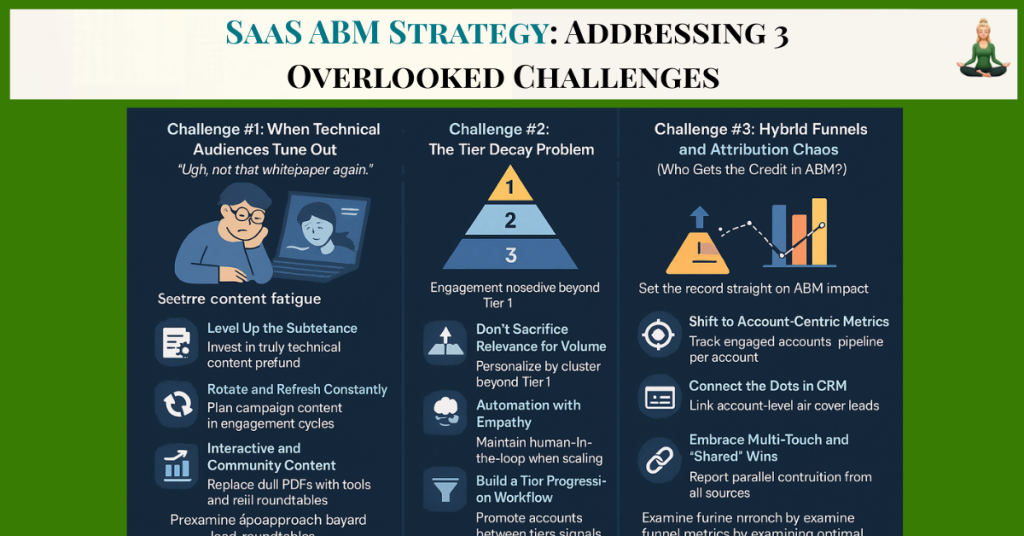Most B2B marketers have adopted ABM now, yet two out of every three of them still cling to old lead-gen metrics.
Why is that?
Because ABM’s promise comes with new pitfalls that first-wave playbooks never addressed.
I mean, most ABM guides still are too high-level, like this one:
But this guide skips the tired clichés (I won’t bore you with ICP 101 or basic segmentation) and talks straight about three common (yet overlooked) challenges plaguing your SaaS ABM strategy:
- Content fatigue
- Tier decay
- ROI attribution chaos in hybrid funnels
and how to solve them (Plus, the role of ZenABM).
Read on…
Addressing 3 Common (Yet Overlooked) Challenges That Plague Your SaaS ABM Strategy: Quick Summary
- Technical Content Fatigue: Avoid repetitive, superficial content. Instead, deliver genuinely technical, novel, persona-specific, and interactive resources.
- Tier Decay at Scale: Prevent loss of personalization by clustering and tiering strategically, using smart automation, creating dynamic tier progression, and empowering your broader GTM team.
- Hybrid Funnel Attribution Chaos: Adopt account-centric metrics, ensure CRM and ABM platforms integrate without friction, and embrace multi-touch attribution/parallel attribution models to clearly demonstrate ABM’s value.
- ZenABM’s Role: ZenABM tackles content fatigue through intent-based content targeting, mitigates tier decay with dynamic account engagement tracking, and clarifies attribution with plug-and-play dashboards showing ABM’s parallel influence on revenue.
Challenge#1: When Technical Audiences Tune Out (Content Fatigue is Very Real)
“Ugh, not that whitepaper again.”
If you’re marketing to developers, engineers, or any technical persona, you’ve probably seen that eye-roll.
Today’s B2B buyers are drowning in content. 54% say they feel overwhelmed by the sheer amount of it. Plus, 75% of B2B ads score very low on emotional connection metrics.
And highly technical folks are great fluff detectors. They prioritize depth and authenticity, and anything that smells like generic marketing fluff gets ignored.
The result?
Severe content fatigue!
See, technical stakeholders often sit through countless demos and read endless docs, so they’re fatigued not just by volume, but by repetition.
By the time your fifth outreach email hits their inbox, the CTO or DevOps lead at a target account might be completely desensitized.
For SaaS companies targeting developers or IT, if your content doesn’t spark genuine interest, your SaaS ABM strategy will stall there and then.
How to Re-Energize Technical Personas
Here’s how you can fix the technical content fatigue:
Level Up the Substance
Invest in truly technical content that respects your audience’s expertise. Swap out fluffy thought leadership for engineer-to-engineer resources (e.g. in-depth case studies, architecture diagrams, API how-tos, even code samples).
Earn credibility by speaking to real problems (and actually solving them). You can consider involving your own engineers or product team in content creation to hit the right tone.
For instance, at Userpilot, they started PITT (Product Innovation Think Tank) to bring content for Product Managers from Product Managers/Thinkers themselves:
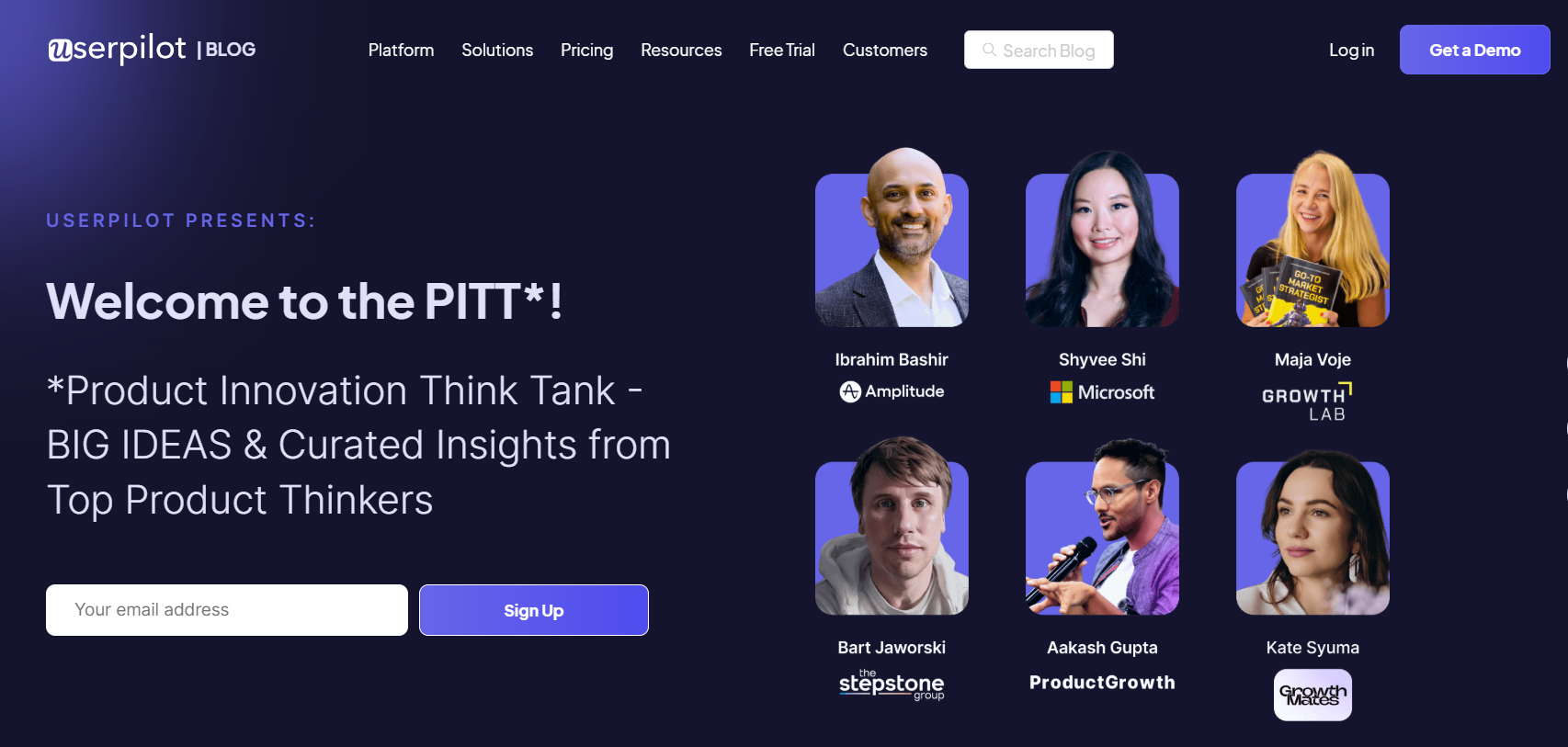
Rotate and Refresh Constantly
One surefire way to bore a technical buyer is to show them the same ad or asset over and over.
Ad fatigue is ABM’s silent killer.
As ABM practitioner Anna Tsymbalist puts it in a LinkedIn post by Let’s Talk ABM Podcast, “Ad fatigue is killing your ABM campaign. Your audience has seen it enough and turned off…Run engagement cycles: rotate content every 2 weeks to keep things fresh.”
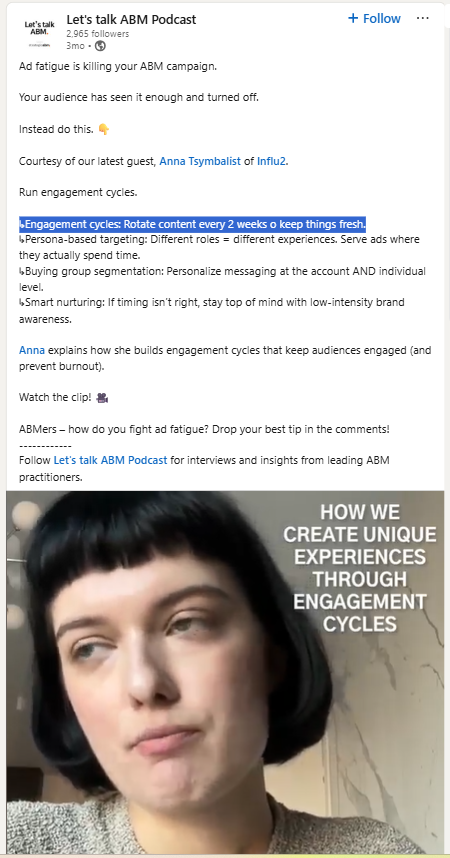
In practice, that means planning your campaign content in “engagement cycles”: serve a sequence of ads or emails for a few weeks, then switch up the creative, format, or message.
Personalize by Persona (Really)
It’s ABM 101 to design specific content for each account/segment of accounts, but within technical accounts, you have multiple personas (e.g. a software architect cares about integration and scalability, while a CIO focuses on ROI and security).
Don’t lump all ‘tech geeks’ together.
Create distinct tracks: one for developers (deep dives, maybe an interactive sandbox or GitHub repo), another for IT managers (tech roadmap, compliance checklists), etc.
Also, meet all personas where they dwell.
For example, share your app performance tips on Hacker News to grab engineers’ attention, while posting social media marketing success stories on LinkedIn.
Interactive and Community Content
Technical folks often prefer hands-on learning and peer input.
So replace yet another PDF guide with a free tool or calculator (e.g. cloud cost estimator), an interactive webinar (live coding, AMA style Q&As), or community-driven content.
For instance, Tarek Reda (Founder at Blue Pencil Marketing Agency), using Lovable, has turned his website into a resource hub with budget calculators, a revenue leak detector, etc.
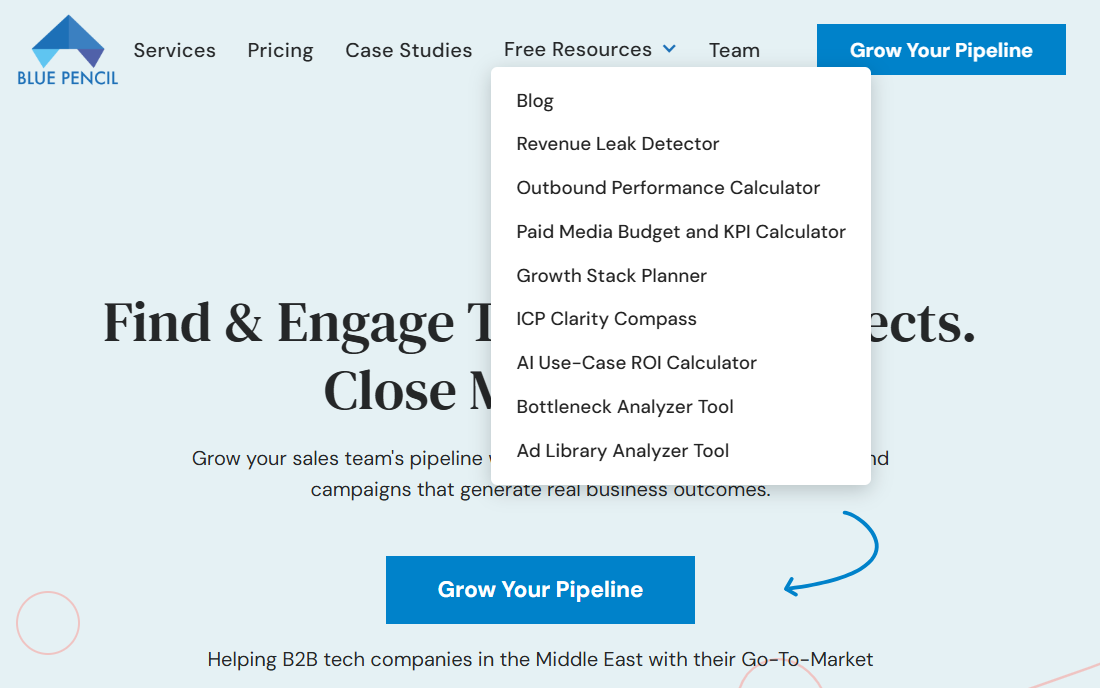
You can host a small roundtable with engineers from your customer accounts as speakers – your prospects might tune in to hear their peers’ experiences, where they’d ignore your sales deck.
The key is to provide value and novelty: something they haven’t seen 10 times already this quarter.
Challenge#2: The Tier Decay Problem
ABM doesn’t always scale gracefully.
Many SaaS teams start with a pilot on 20 high-value accounts (Tier 1, one-to-one ABM) and see great engagement.
Encouraged, they expand to a couple hundred Tier 2 accounts (one-to-few) and maybe thousands in Tier 3 (programmatic ABM).
Suddenly, the personal touch wanes, campaigns feel templated, and results nosedive beyond the top tier
This “tier decay” manifests as diminishing conversion rates and engagement as you go down the tiers.
Why?
Because what made ABM work at a small scale (extreme relevance, human touch, focus) gets diluted when stretched across too many accounts without the right strategy.
In fact, according to research by Kerry Cunningham, only 4% of ABM programs are “fully scaled,” while over half remain stuck in early development.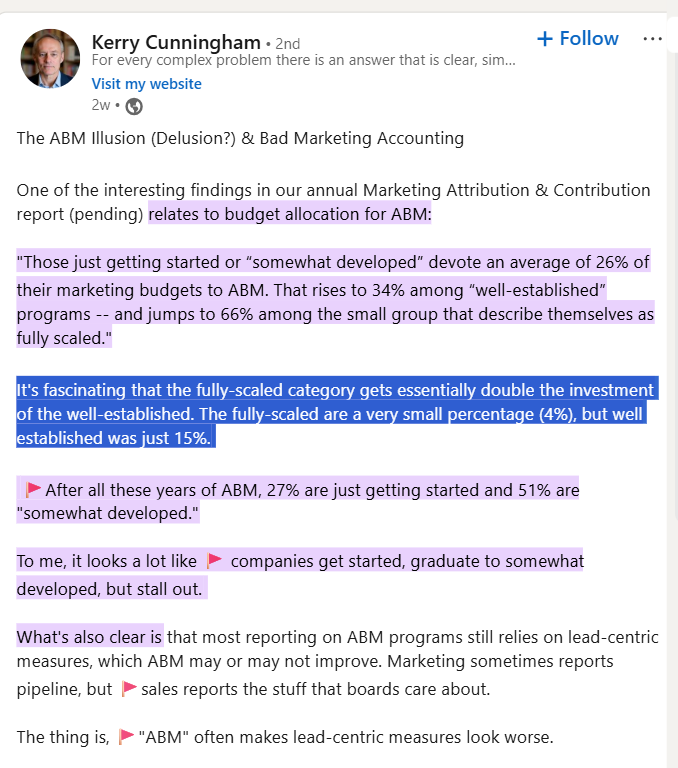
How to Prevent ABM at Scale from Turning into “Spam at Scale”
Here’s how you can tackle tier decay and scale ABM without compromising ROI:
Don’t Sacrifice Relevance for Volume
Stop treating Tier 2 or 3 account segments like a traditional lead gen list and design a tiered personalization model.
For example, cluster Tier 2 accounts by key characteristics (industry, problem, product use-case) and build semi-custom campaigns per cluster.
I’m not talking about creating 200 unique ad assets, but maybe 10 personalized creatives for a cluster of 20 accounts with similar pains and traits.
Josh Weale (Director of ABM at Strategicabm) notes in his ABM personalization guide that just putting a company logo on an ad or using someone’s name (i.e. token personalization) won’t cut it. You must deeply understand your target accounts’ needs, challenges, and priorities and translate that knowledge into meaningful content and engagement strategies.
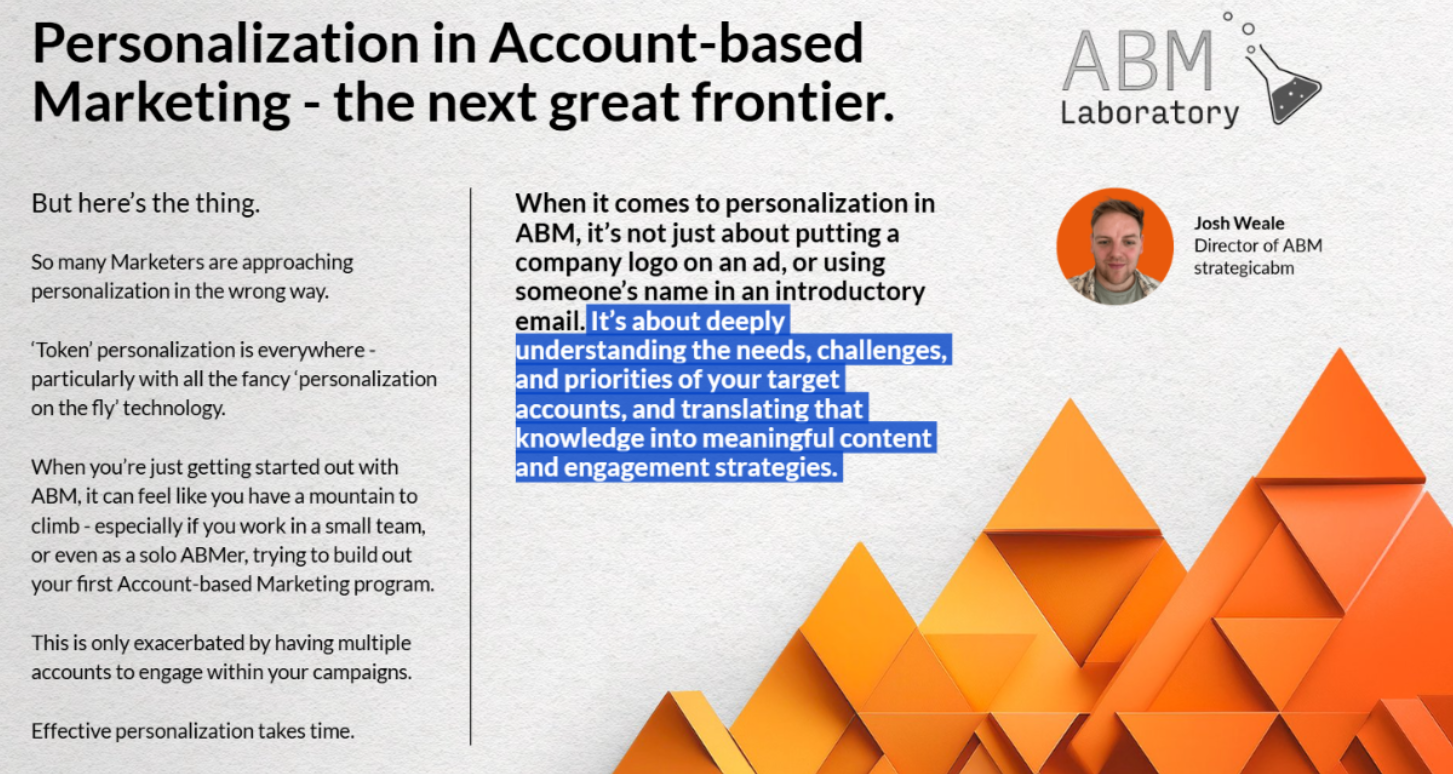
He prescribes a scaled personalization method – ‘From Cluster to Account to DMU to Stakeholder’ :
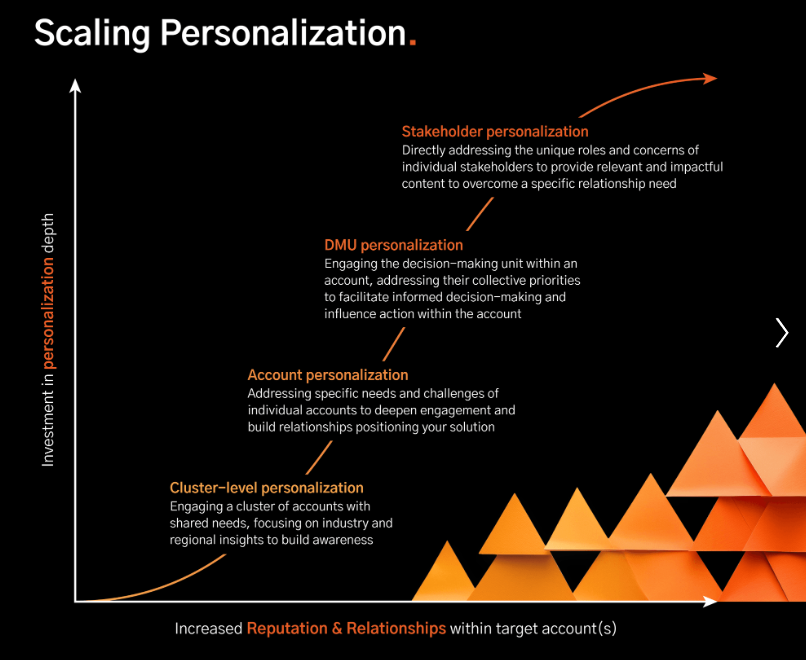
Automation with Empathy
Automation is your friend for scaling, but only if you use it wisely.
Utilize ABM platforms and marketing automation to do heavy lifting (e.g. dynamic content insertion, triggered emails based on account behavior), but don’t “set and forget.”
Maintain a human-in-the-loop to monitor quality.
For instance, you might use an AI tool to generate a custom intro snippet for each account in an email, but have a marketer review 20% of them to ensure they actually make sense.
The key is to automate the grunt work but not the judgment.
Also, automate account research: use tools to pull firmographic and technographic data or recent news into your CRM so your team can quickly personalize outreach with relevant talking points at scale.
I’d suggest Clay for this.
Build a Tier Progression Workflow
One cause of tier decay is static tier assignment.
If an account in Tier 2 shows surging engagement or intent, it deserves Tier 1 treatment suddenly, but many programs don’t have a mechanism to adjust on the fly.
Set up a system (in your CRM or ABM platform) to promote or demote accounts between tiers based on real-time signals.
For example, if a Tier 3 account suddenly has 5 buyers from the company on your website and two attend your webinar, upgrade it to Tier 2 or even Tier 1 and alert the account team.
Conversely, if a Tier 1 account goes cold for 6 months, consider downgrading its intensity to free up resources.
Empower the Extended Team
To scale ABM across many accounts, get sales and customer success teams involved in your SaaS ABM strategy.
You can start with training BDRs and AEs to customize their outreach and share intel from the field.
It might mean arming CSMs with expansion plays for current customers (Tier 1 ABM should include key customer accounts too).
One tactic is to create a “Tier 2 toolkit” for sales: provide semi-customizable email templates, relevant case studies by vertical, and battle cards so reps can pick and personalize for each account quickly.
Measure Tiered Performance and Adjust
Often, tier decay goes unnoticed because teams measure surface results.
Break out your funnel metrics by tier and ask:
- What’s the engagement rate on Tier 1 accounts vs Tier 2?
- Conversion to opportunity? If Tier 3 ads are delivering 1/10th the click-through of Tier 1, that’s a sign to rethink or possibly cull your approach for Tier 3.
- You might find you should focus on Tier 1 and 2, and pause Tier 3 until you can do it properly.
- On the other hand, if certain plays are working at lower tiers (e.g. one industry-focused campaign in Tier 2 that’s generating SQLs), double down there.
In short, treat tier performance data as a feedback loop to continuously optimize your program design.
Challenge#3: Hybrid Funnels and Attribution Chaos (Who Gets the Credit in ABM?)
In SaaS, it’s rare to run pure ABM in a vacuum.
More often, you have a hybrid go-to-market – a mix of ABM for strategic accounts, plus inbound marketing, plus maybe product-led growth (free trials or freemium users trickling in).
This is healthy for the pipeline, but a nightmare for attribution.
When an enterprise deal finally closes, Sales leadership might say, “That came from our outbound effort.”
Marketing might point out that the prospect downloaded two e-books and attended a virtual event, and your ABM platform shows the account had high engagement scores all along.
So…who “gets credit”?
And “it doesn’t matter, it was a team win” doesn’t help here because ABM is expensive!
How to Set the Record Straight on ABM Impact
Here’s the attribution method to truly measure the impact of ABM grain by grain:
Shift to Account-Centric Metrics
If you want to prove ABM, you must measure like ABM. In addition to (or instead of) traditional lead funnel metrics, track things like accounts in the engaged stage, accounts with opportunity, pipeline and revenue per target account, and account win rate. For example, report that “Of our 100 target accounts this quarter, 30 engaged (3+ buying signals), 10 became opportunities, and 5 closed – a 50% win rate on engaged accounts.” Compare that to baseline win rates in non-ABM accounts. This gives a far clearer picture of ABM’s efficacy.
Pro Tip: Some teams even designate MQAs (Marketing Qualified Accounts) to replace MQLs using thresholds of account engagement to signal an account is sales-ready. ZenABM can help you with this if you’re running ABM on LinkedIn. Just set your own engagement thresholds for the ‘interested’ stage, and as soon as an account hits the threshold, ZenABM will assign a BDR in your CRM to that account:

Connect the Dots in CRM
Far too often, an individual from a target account fills out a form and gets routed to the SDR as a generic MQL, with no link to all the account-level air cover you’ve been providing. You must set up a workflow to tackle this.
Pro Tip: ZenABM adds new accounts to your CRM as they cross certain ad engagement thresholds, and also pushes all the account’s engagement data as company properties to your CRM:
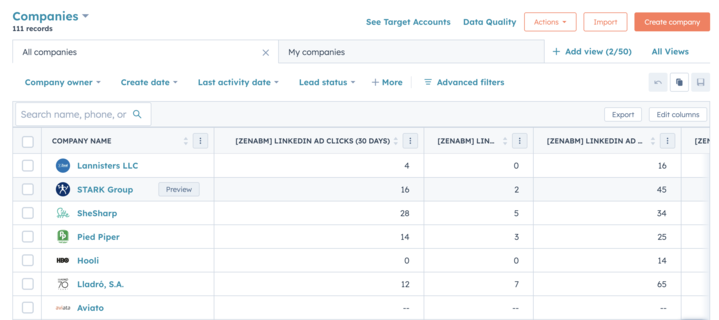
This workflow ensures the sales team knows all the accounts being influenced by ABM and doesn’t have to cross-check with marketing now and then.
Embrace Multi-Touch and “Shared” Wins
In a hybrid funnel, marketing and sales will both touch the deal.
Trying to fight over who gets 100% credit is a losing battle.
Instead, change the narrative to influence over attribution.
Either use multi-touch attribution models that credit multiple sources, or simply report on contribution in parallel – e.g., “This quarter, ABM campaigns influenced 40% of closed deals and 60% of pipeline by value” alongside whatever sales-sourced metric exists.
Again, ZenABM can help you to report ABM contribution in parallel.
It matches the companies engaging with your LinkedIn ads to the ones in your CRM and pulls their deal value to clearly show the impact of your ABM campaign by value and other metrics like total accounts targeted, total deals closed that were influenced by ABM, ROAS, etc.

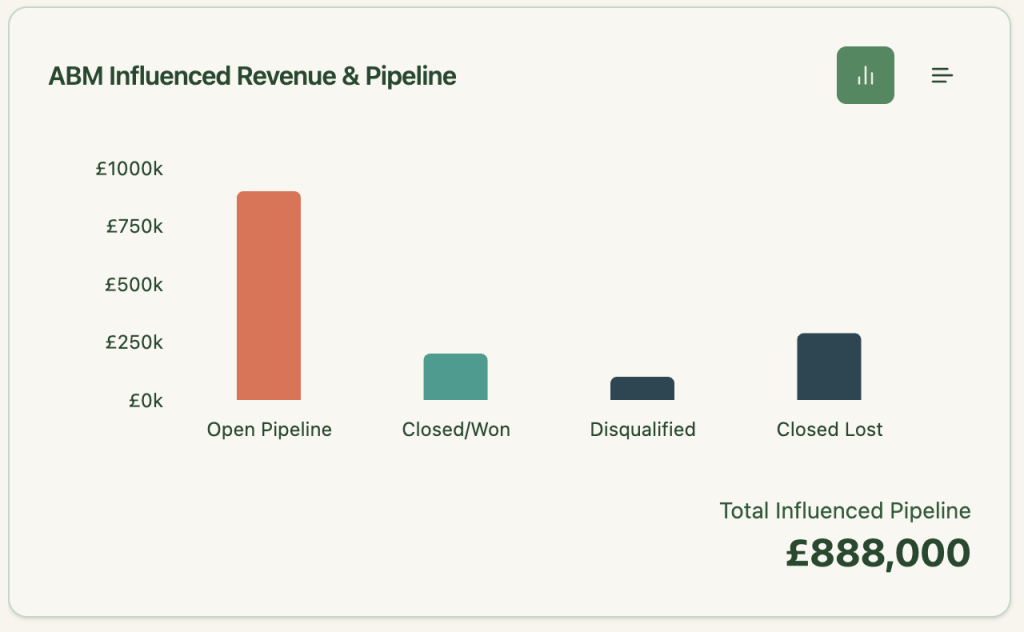
ZenABM for Nailing Your SaaS ABM Strategy
We discussed the problems with scaling the SaaS strategy above and their solutions.
Let’s see how ZenABM can help you execute those solutions:
Company-Level Engagement Tracking Per Campaign With Intent Tags
ZenABM can help you tackle content fatigue by analyzing the intent of a target account, so you can show them targeted BOFU content they want and not repetitive TOFU content.
For instance, if you run different campaign groups, each based on a particular feature of your SaaS product, something like this:
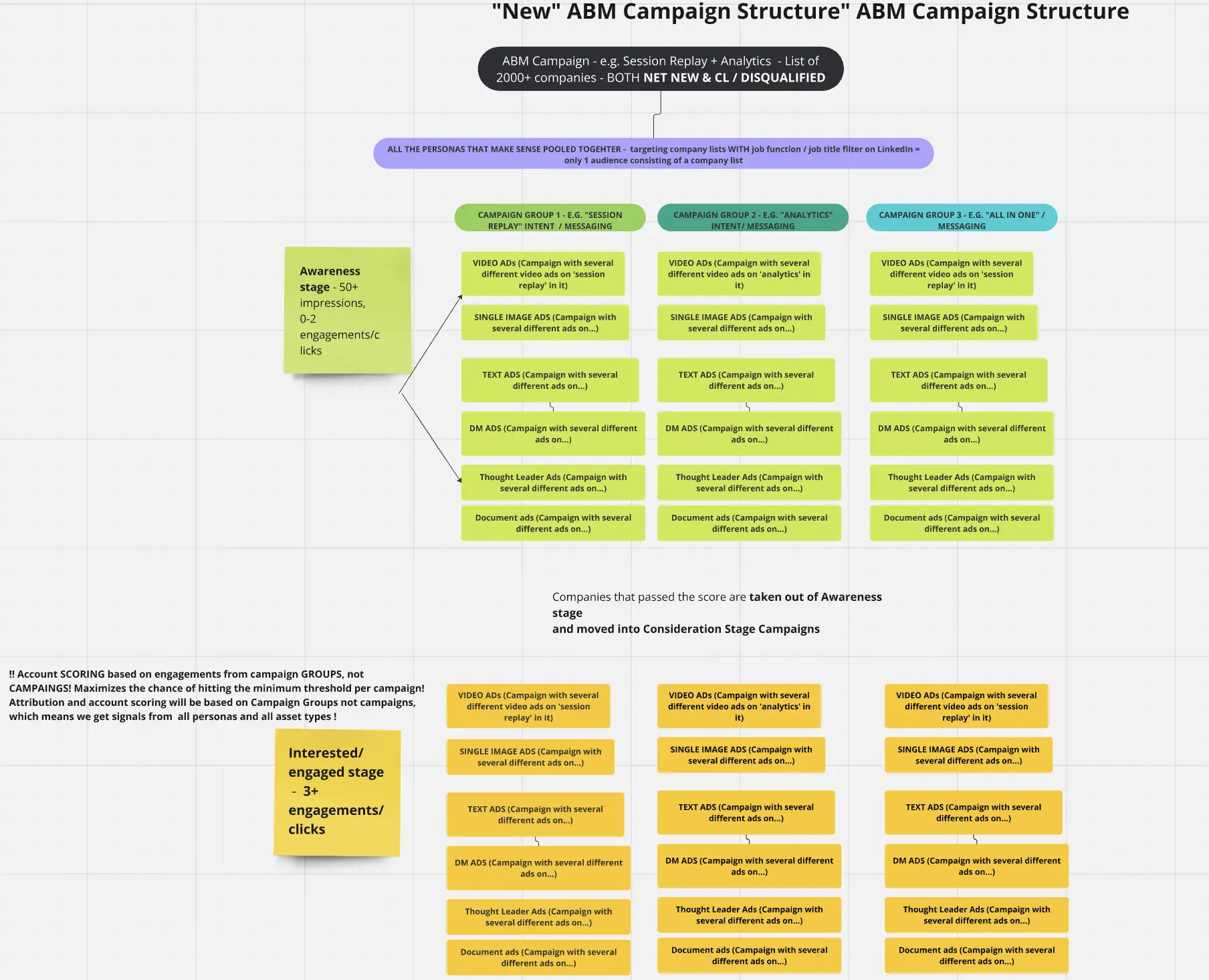
ZenABM will track each company’s engagement with each ad campaign group and bring all accounts showing similar intent together, along with the intensity of engagement and stage:
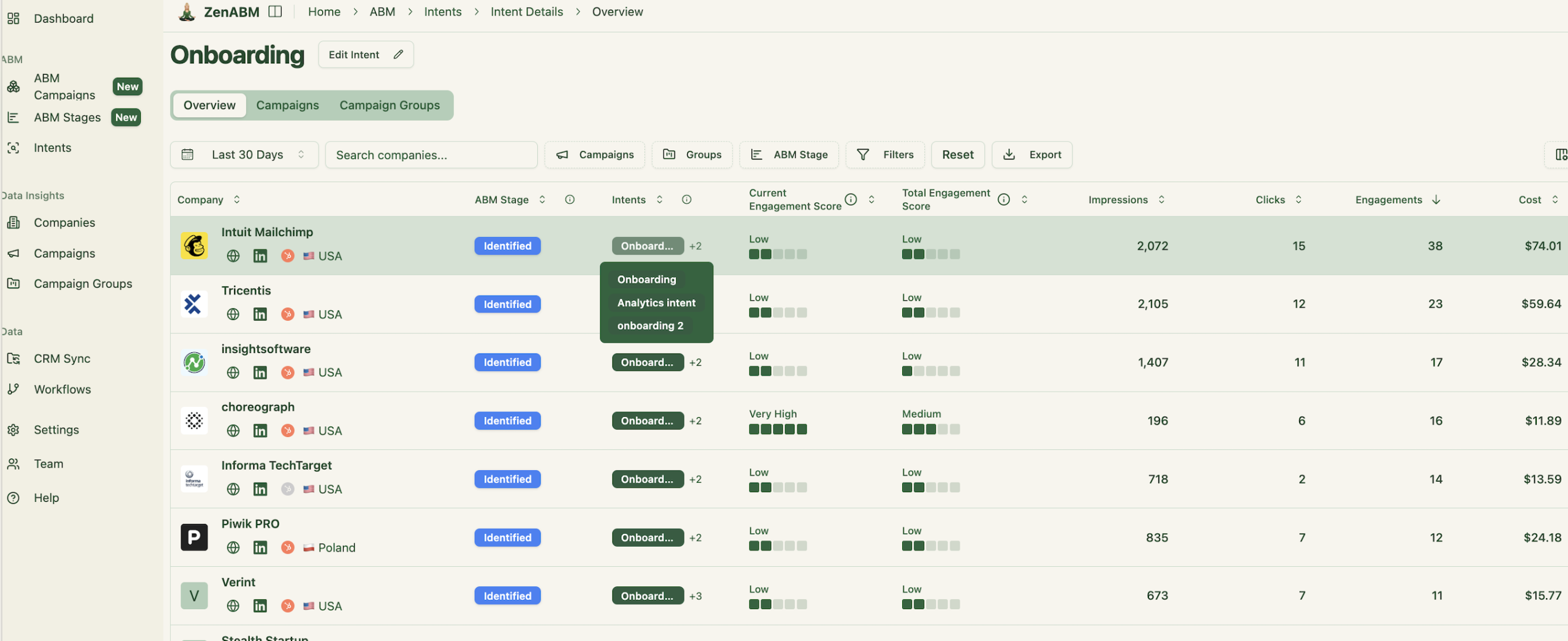
The same engagement data and intent are also pushed automatically to your CRM as company properties:
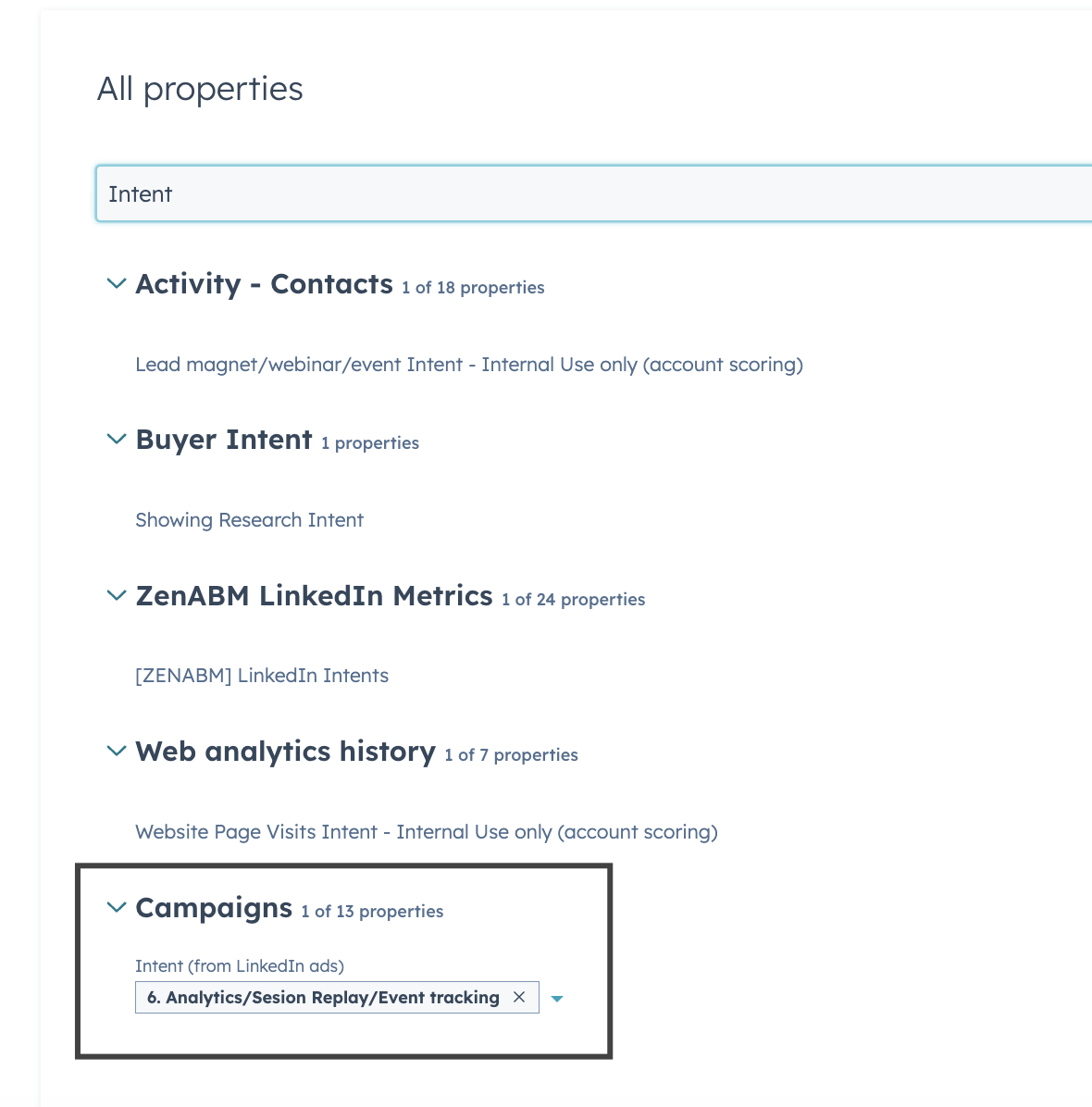
Based on this data, you can show ads that match their interest/pain-point and buying stage, instead of random TOFU content, which sounds the same for each SaaS business.
This ensures you show what the prospect wants to see and eliminate content-fatigue and tier-decay as you scale.
Example: If an account shows heightened engagement with, say, ‘User onboarding’ ads, it’s a sign that they are looking for tools to help them with user-onboarding, product demos, initial feature adoption, etc. Then you can show them more BOFU ads pertaining to this very specific feature, instead of showing random TOFU content.
Plug-and-Play Attribution Dashboards
We discussed how most SaaS businesses run a lot of initiatives like ABM, PLG, inbound, PR, etc. at the same time and it causes ROI attribution battles between departments.
The solution we discussed was ‘Parallel attribution’, where instead of fighting over who deserves the credit for a deal-closure, we acknowledge all he deals that had any impact of ABM on them (e.g. 60% of the closed deals this quarter were influenced by ABM).
And ZenABM can help you with this.
It matches the companies engaging with your LinkedIn ads to the ones in your CRM and pulls their deal value to clearly show the impact of your ABM campaign by value and other metrics:


The key is to not stress over the *only* winner but see the number of deals and pipeline influenced by ABM, even if there were other campaigns at play too.
Because at the end of the day, it’s B2B – the sales cycles here are mult-channel, multi-touchpoint oriented and not straight funnels through with an ICP slips into your customer base 🙂
Over to You
SaaS ABM faces three common problems, especially as you scale:
- technical content fatigue
- tier-decay
- attribution chaos
ZenABM can fix them by tracking company-level engagements, automating dynamic content targeting based on intent, and providing parallel attribution models.
So, stop overlooking these issues and fix your SaaS ABM strategy now with ZenABM for free.
You can also book a demo here to understand more about the tool.

